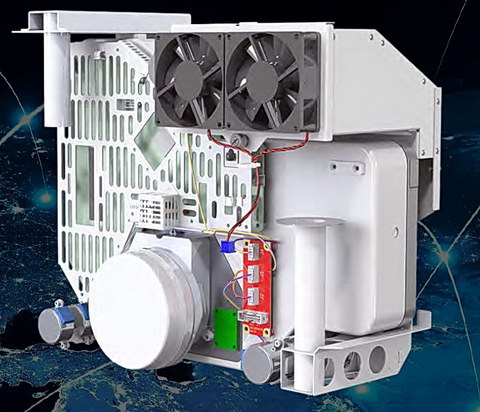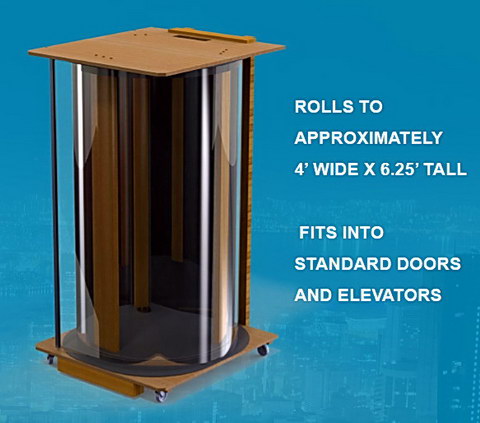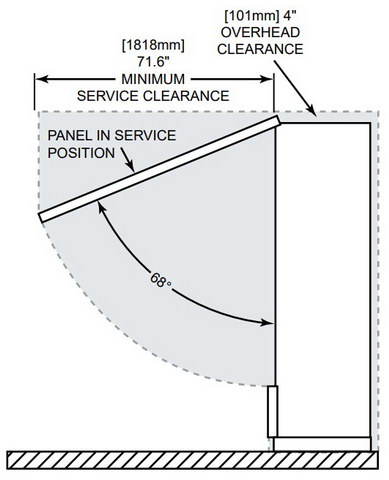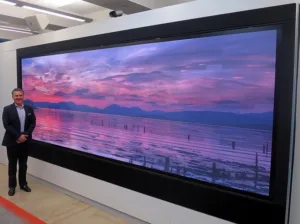Prysm Inc. was founded as Spudnik in 2005, discussed its laser-phosphor display (LPD) at ISE 2010 and formally introduced its first generation TD-1 module as a product at InfoComm in 2010. This Prysm module was designed to be tiled into arbitrarily large arrays, much like a rear-projection cube for a control room or a LED videowall module.
Prysm had a booth at ISE in Amsterdam in February and I asked about their LPD because they were not showing on the floor. I was told they were still manufacturing and selling the LPD but were not showing it at ISE because they were introducing the second generation product in March and did not want to show the older version.
Dr. Roger Hajjer and the new Prysm LPD 6K 190 display. (Credit: M. Brennesholtz)
I went down to the Prysm demonstration suite in New York to see the new unit displayed just before its launch on March 15th where Dr. Roger Hajjer, founder and CTO of Prysm, gave me a complete explanation of the technology. The second generation, called the LPD 6K, comes in two versions, in sizes of 135” and 190” diagonal. The new system uses the same basic LPD scanning system and the scanning engines are tiled. The big change between the first and second generations is that the second generation uses a monolithic screen, instead of the individual screens used in the previous generation. This made the spaces between the tiles nearly invisible – you had to look hard for them to see them at all.
 Prysm laser scanning engine (Credit: Prysm)
Prysm laser scanning engine (Credit: Prysm)
The LPD scanning technology works by scanning four 405nm laser beams in each engine across the screen. The screen is coated with vertical stripes of red, green and blue phosphor, along with black guard-bands that separate the phosphor stripes. There are index marks on the back of the phosphor screen that are precision aligned with the phosphor stripes. This index alignment layer is dichroic and transmits the 405nm laser light but reflects the red, green and blue light toward the audience. The engine can detect these index marks and uses them to ensure the laser beams fall on the correct color stripe. The laser beams then excite the phosphor which emit the red, green and blue light to form the image. The servo control of the laser beams is automatic and continuous and adjusts for things like screen position changes with temperature or humidity.
When seen from very close, the structure of the Prysm screen is visible. (Credit: M. Brennesholtz)
For example, when one of the 100µm wide laser beams falls on the 340µm blue stripe, the laser is pulsed on by the amount required to produce the needed blue light called for by the video signal. As the beam sweeps off the blue stripe onto the red stripe, it is again pulsed on, this time to produce the amount of red light called for by the video signal. This scheme is virtually identical to a beam index CRT system except for the substitution of a laser beam for the electron beam.
The laser beams are scanned with a field rate of 360Hz. A 3:1 interlace system is used so each pixel is illuminated at a frame rate of 120Hz. According to Dr. Hajjer, the system produces Rec. 709 colorimetry, although the specification sheet says about 91% – 94% of Rec. 709. This is not surprising because the HDTV Rec. 709 colorimetry specification was developed to match phosphor-based HDTV systems such as CRTs and plasma displays. He told me they were working on a new phosphor system that will come closer to the DCI/P3 color gamut but is not ready yet.
The horizontal pixel pitch is 1.2mm, corresponding to the three phosphor stripes each 340µm wide and the three black guard bands each 60µm wide, producing a 85% fill factor. Closely examining the screen makes these red, green and blue vertical stripes visible but at normal viewing distance they cannot be seen. The vertical pixel size is defined by the scanned laser beams and is 0.8mm, leading to pixels that are not square.
The black stripes are visible from both the front of the screen and the rear. From the rear, they supply a guard-band to ensure laser light intended for the blue stripe does not fall on the adjacent red and green stripes, reducing color saturation. From the front, they absorb some of the ambient light falling on the screen, increasing contrast in the presence of ambient light.
 The monolithic LPD 6K screen will roll with a radius of about 15” (38cm) for shipping (Credit: Prysm)
The monolithic LPD 6K screen will roll with a radius of about 15” (38cm) for shipping (Credit: Prysm)
The phosphor stripes are made on flexible substrates each 20” wide by 15” high (50.8cm x 38.1cm), the same size as the optical modules. These screen segments are then laminated to the rear of a 4.5mm thick polycarbonate screen that is smooth on both sides. Dr. Hajjer explained this choice of thickness provided two important properties: it felt rigid to end users touching the screen but was flexible enough for the monolithic screen to be rolled for shipping. The polycarbonate substrate was not completely clear but had a transmission of 60%. This added to the ability of the screen to have good contrast in the presence of ambient light.
Lifetime of the Prysm screen is nearly unlimited and the company has only seen a 1% decrease in screen output over a 100,000 hour life. The Prysm laser scanning engines, however, have a more limited life, declining to 30% of the initial 800 cd/m² output after 60,000 hours. Contrast is said to be 80,000:1 with no ambient light. (Note: the data sheet says 50% at 60,000 hours from an initial calibrated brightness of 250 cd/m².) The phosphors have a lambertian emission pattern and the screen shows no color or brightness shift from any angle.
 The Prysm LPD 6K is designed to be mounted flush to the wall and serviced from the front. (Credit: Prysm)
The Prysm LPD 6K is designed to be mounted flush to the wall and serviced from the front. (Credit: Prysm)
In New York, the LPD 6K 190 was installed away from the wall to allow the rear of the system to be seen. (Credit: M. Brennesholtz)
The Prysm is designed for front service and can be installed nearly flush with the wall. The structure rests on the floor and is not hung from the wall. The screen assembly lifts as a unit to enable access to the individual laser scanning modules. Power consumption is 1500W typical, 2600W maximum with a full white screen. The unit qualifies as a Class 1 Laser Product.
Prysm is currently focusing on 60” high screens, or a four-high stack of its laser scanning modules. For the 190” product I saw in New York, the system was 9 modules wide, for a total of 36 modules and a screen size of 180” x 60” (4.6m X 1.5m). The 135” product has a stack of modules 6 wide by 4 high producing an image of 120” x 60” (3.0m x 1.5m).
Dr. Hajjer said Prysm is focusing on the education, training and conference room markets where 36 point IR touch screen technology from Prysm is used by its customers. This is one reason to limit the height of the system to 60” – that is the highest touch screen most people are comfortable using. He added that the polycarbonate material used in the screen substrate comes 88” (2.2m) wide by nearly unlimited length, so Prysm could build larger displays if the market developed for them. The next size to be developed, according to Dr. Hajjer, will be a 225” unit, 11 modules wide by 4 modules high.
I asked Dr. Hajjer about the price of the system but he declined to be specific. He did say that it was priced lower than LED videowalls but higher than tiled LCDs. He did comment that if Prysm could achieve a 1% penetration into the tiled LCD market, the volume would drive the price down to the point where it would be price competitive with LCDs but would not have the visible bezels.
The complete data sheet on the Prysm LPD 6K 190 can be downloaded from the Prysm website. The company has already begun deliveries of the LPD 6K to selected customers. –Matthew Brennesholtz

